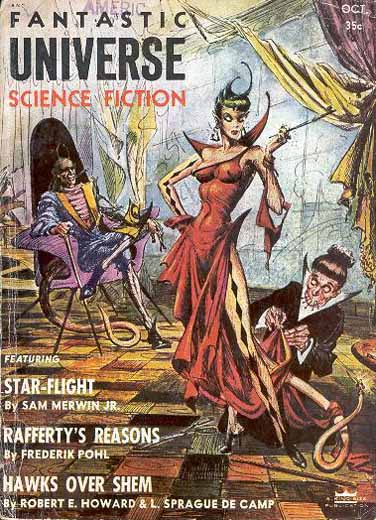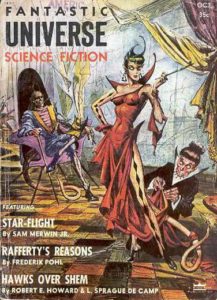Magazine Review: Fantastic Universe October 1955 edited by Leo Margulies
Fantastic Universe was a digest-sized science fiction and fantasy magazine that ran from 1953 to 1960, originally coming out from King-Size Publications. Its quality is considered to have fallen off after 1956, with lesser stories and more emphasis on pseudo-science articles, but this particular issue is from the “good” period.
We open with a brief essay by Frank Belnap Long, inspired by the Kelly Freas cover and talking about the mythic figure of the Horned Man. None of the other stories are related to the cover.
“Star-flight” by Sam Merwin Jr. concerns a young woman named Francesa Hawley-Bey, a student at a Martian university. She’s in her early twenties, but has the physical development of a nine-year-old. She learns that she is the product of a centuries-long breeding experiment to create near-immortality. Why, you ask? Well, it turns out that there’s no such thing as faster than light travel. Humanity can build ships now that get really close to light speed (something that’s been kept from the general public), but it will still take immense amounts of time to reach the stars.
The scientist who’s been working on these new ships is being hunted because he doesn’t want to give one planet (Earth in this case) a monopoly, as their government wants to use the new technology merely to strip-mine the rest of the solar system. He, it turns out, is secretly the only other immortal and has been waiting thousands of years for a co-pilot so he can get back to galactic civilization.
The general skeeviness of Fran having her entire life manipulated so that humanity can eventually go to the stars is overwhelmed by the particular skeeviness of the romance subplot between her (remember, physically nine) and her thirty-something college dean. In fairness to the dean, there are hints he might have been brainwashed into this, but eww. Also note, romance only–this isn’t that kind of story.
“The Nostopath” by Bryce Walton is about a man named Barton who is all too happy to be assigned to a remote one-man watch station during war with aliens. He didn’t like it much on Earth, with all those people, and his annoying family. At first, he greatly enjoys the solitude. After some months, however, he starts craving some company, and sends a message off to HQ with suggestions.
Headquarters think that Barton’s ideas are jolly good, and soon, a small, carefully selected group of people joins Barton on the asteroid station. This includes Barton’s wife and child, who have learned from his long absence to really appreciate him. They all get along swimmingly, and Barton’s World is a model community.
Which is great, until the war is over, and the military wants Barton to come back to Earth. And for some reason, the crew of the pickup ship doesn’t have orders to let anyone come with him. Chilling ending as we learn what’s really going on.
“An Apartment for Rent” by Ruth Sterling focuses on the title apartment, which is quite nice. However, since the sudden death of the long-time inhabitants, the rental office has been unable to find anyone who will stay in it for more than a month, despite the housing shortage. The rental manager thinks the new couple he’s meeting might just be the ones who will fit the apartment. They do seem rather taken with it…and might be staying forever. It seems the housing shortage is worse than you might have thought. Slight but amusing.
“Rafferty’s Reasons” by Frederik Pohl takes place in a dystopian future which has achieved full employment by banning most technology. Except for teaching machines that will beam necessary job skills into your head. Rafferty is a bookkeeper who used to be an artist (art was declared “not a real job”) and hates his boss, Girty, who is high up in the political structure of the New Way. He’s reached the breaking point, and is determined to strike back any way he can. Downer ending.
Girty is a thoroughly hateable character, with a combination of “bad boss” and “bad conservative” personality traits that make Rafferty’s reasons understandable.
“Hawks Over Shem” by Robert E. Howard and L. Sprague de Camp is the centerpiece of the issue. It’s a rewritten version of Mr. Howard’s story “Hawks Over Egypt” that Mr. de Camp translated into the Hyborian Age setting so he could make Conan the Cimmerian the star.
Asgalun is ruled by a king who is, well, nuts. The main thing protecting him from being overthrown is his army, but his three main generals are feuding with each other and jockeying for power. One of the generals, Othbaal, has a checkered path in which he sold out his own mercenaries for a massacre.
The sole survivor of that massacre was Conan the Cimmerian. He’s finally made it to Asgalun to seek vengeance. But as fate would have it, first Conan accidentally gets involved with an assassination attempt on a man who turns out to be Mazdak, one of the other generals. Conan would not have interfered, but the assassins decided they didn’t want any witnesses, and our barbarian protagonist isn’t just going to lie down and die.
Mazdak is grateful to Conan, and Othbaal dying fits into his own plans. So the pair teams up to infiltrate Othbaal’s palace so that Conan can have his revenge. Othbaal’s concubine Rufia wisely runs away as her unwanted master is disposed of. Unfortunately for her, it’s currently illegal for women to be out in the street at night, and she runs into King Akhirom in disguise.
As it happens, fleeing murderous barbarians is not a defense under the law, and so Rufia is about to be executed. Then she gets a brilliant idea, playing into Akhirom’s delusions of grandeur, and getting him to declare himself a god (and herself his first worshiper.) That saves her neck for the nonce, but now God-King Akhirom is determined to push the new religion on the entire city.
Chaos ensues, and Conan is recognized as Amra, the famous pirate with a reward on his head! How will he escape a city gone mad?
Note: child sacrifice and implicit rape are part of the story.
This story has been reprinted several times as part of Conan collections, so should be relatively easy to track down.
“Pink Fluff” by Craig Rice is set in an old house that an architect and his family have recently moved into. There’s currently some amount of marital discord, not made any easier by the appearance of the title substance, which seems to have no visible source, and vanishes just as mysteriously when you aren’t looking. And it’s getting thicker….
It is painfully obvious to say that this is a “fluff” story, but yes. It is.
“Run Around the Moon” by Matt Carter takes place in small-town Minnesota. An astronaut who accomplished many great feats of exploration is retiring to his family farm. A humble man and solitary by nature, he’s hoping to get some peace and quiet. But Lars Hendricssen hasn’t counted on just how famous he’s become.
Lars is the biggest thing to come out of that little town, and they want to exploit it to the hilt. Tourists and sightseers, professors and legislators, all want a piece of Lars’ time and personal space. Plus, there’s space-happy kids trampling all over his flowerbeds and being loud and enthusiastic all day.
Fortunately, one of Lars’ old crewmembers comes for a visit, and he’s got an idea for a project to keep the kids busy for a good long time.
I’m a sucker for Minnesota-set stories, and I like the humor in this one.
“Universe in Books” by Hans Stefan Santesson is his first review column for FU. He would later become editor of the magazine. He likes the more intellectual sort of science fiction, rather than the space opera whiz-bang stuff.
“You Created Us” by Tom Godwin is about a secret community of atomic mutants created by the tests in the Nevada desert in the late Forties/early Fifties. The protagonist has a metal plate in his head, and this allows him to realize that the lizard people are there, despite their mental powers. Perhaps he should not have gone into their lair alone.
This is the sort of thing that might have been turned into an Outer Limits story back in the day. It’s very much a product of the fear of nuclear war.
A different sort of doomsday scenario is seen in the final story, “Weather Prediction” by Evelyn E. Smith. George is terrible at remembering numbers, particularly telephone numbers. So when he claims to have called the weather line and been told that rain is coming, his wife Elinor and her friends laugh. It’s going to be warm and clear! Until it isn’t. And then George tells them the rest of the prediction…but who did he actually call?
Some sticklers for religious dogma might object to the ending.
An interesting issue, but a couple of the stories leave a bad taste in my mouth.


